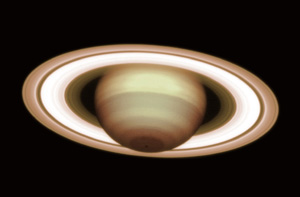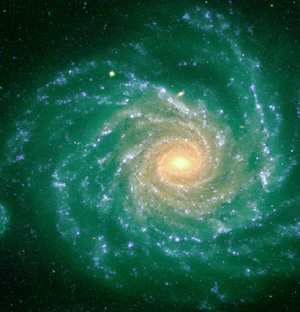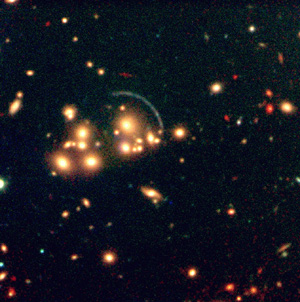

The Venus Transit 2004
... Extended InfoSheet G5
Distances in the Universe
Why should we know them?
Because they provide a
- starting point for astrophysics: The distance of any object in the Universe is a decisive parameter for understanding its energy generation mechanisms. An uncertainty of a factor of 2 in the distance means an uncertainty in the power output in error by a factor of 4.
- starting point for cosmology: Distances are necessary in order to determine the structure, evolution and age of the expanding Universe.
What is the "distance ladder"?
This is the procedure to measure progressively larger comic distances. Objects with well-known properties are used to calibrate larger, brighter and more distant objects, which can in turn be used to calibrate other distance indicators that may work for objects that are seen to greater distances. After several such steps we get means to measure cosmological distances.
Cosmic rulers and distance units
The kilometer, while very practical to measure distances on the Earth, is much too small a unit to be used in astronomy. Astronomers use two different distance units (rulers) to measure the universe.
The first one, useful within the solar system, is the Astronomical Unit (AU): this is the mean distance of the Earth from the Sun (original definition)
1 AU = 149 597 870 691 m (149.6 million km) = 499.005 light-seconds
One light-second is the distance traveled by the light in 1 second, or 299 792 km.
Another unit, necessary for much larger stellar and extragalactic distances is the light-year (ly). This is the distance traveled by the light during one year:
1 light-year (ly) = 63 240 AU = 9.450 1012 km
Astronomers also use a third distance unit, the parsec (pc) - see below
Distances in the solar system

Giant planet Saturn at a distance of 1209 million km (8.08 AU). The photo is a composite of exposures in two near-infrared wavebands (H and K) and displays the intricate, banded structure of the planetary atmosphere and the rings. (ESO VLT NAOS-CONICA Adaptive Optics instrument on December 8, 2001).
How do we measure the distances?
Historically: After the Kepler's Third Law was discovered, astronomers could determine the relative distances in the solar system. However, to learn the trus size of the solar system, the distance of one planet had to be measured in absolute terms, e.g., in kilometres. They early realised that one possibility to do this was to determine the value of 1 AU by means of observaitons of a Venus Transit.
Today: radar and laser measurements provide distances to
major and minor planets with an accuracy of a few meters.
How far away are the planets?
| Earth - Moon | 0.003 AU |
| Sun - Mercury | 0.387 AU |
| Sun - Venus | 0.723 AU |
| Sun - Earth | 1.000 AU |
| Sun - Mars | 1.524 AU |
| Sun - Jupiter | 5.20 AU |
| Sun - Saturn | 9.54 AU |
| Sun - Uranus | 19.18 AU |
| Sun - Neptune | 30.06 AU |
| Sun - Pluto | 39.44 AU |
| Oort's Comet Cloud | 3000 - 135000 AU |
Stars and the Milky Way

The impressive spiral galaxy NGC 1232, which ressembles the Milky Way galaxy in which we live. The distance is about 100 million light-years. The photo is a composite of three exposures in difference wavebands (colours). (ESO VLT FORS2 multi-mode instrument; 1998).
How do we measure the distances in the Milky Way?
The Milky Way galaxy in which we live is a very large system. If we could see it from the outside, it would ressemble the spiral galaxy NGC 1232 shown in the photo above.
In order to measure the distances to the nearest stars, astronomers use the method of triangulation.
As a result of the motion of the Earth in its orbit around the Sun during the year, the observed position of a nearby star describes a small eclipse on the celestial sphere. The semi-major axis (the angle on the sky) of this ellipse is called the annual parallax (π). The further the star is away, the smaller is the size of the ellipse and therefore the parallax. By measuring the exact value of its parallax, we may therefore find the distance to a star.
Thanks to observations with many telescopes on the ground, as well with the the Hubble Space Telescope and, above all, with the ESA Hipparcos astrometric satellite, we have now measured the parallaxes of stars up to a distance of about 1000 light-years.
The parsec (pc) is another distance unit used for stars and galaxies which derives directly from the above mentioned parallax. One parsec is the distance, from which the semi-major axis of the Earth's orbit is seen under an angle of 1 arcsec. There are 3600 arcseconds to 1 degree and 360 degrees to a full circle, so 1 arcsec is a very small angle indeed. If we have measured the parallax π, then the distance d = 1/π [expressed in pc]. 1 pc = 3.26 ly.
The nearest star, Proxima Centauri, has the parallax 0.77233 arcsec, corresponding to a distance of 1.2931 pc, or 4.22 ly.
Another method is based on the apparent brightness (as we see it in the sky) and the luminosity (the intrinsic brightness, i.e., as it really is) of a star. The astronomers determine the type of a star (its "spectral type") from the observed spectrum and from this they derive its luminosity. Since the apparent brightness of a star decreases with the second power of the distance, a comparison of the luminosity and observed apparent brightness allows to calculate the distance.
Yet another method to determine distances is based on a particular type of stars - the "Cepheids" - unstable supergiant stars of spectral type F-G which pulsate with periods of 2-40 days. In 1912, an American astronomer, Miss Henrietta Leavitt, by studying many hundreds of such cepheids in the Magellanic Clouds, found that there exists a relation between the period and the apparent brightness. Because all these stars were located in the same small galaxy and therefore were at approximately the same distance, she discovered the existence of the so-called period-luminosity relation for cepheids. The slower the pulsation, the higher the luminosity. This basic astronomical relation was later refined by other astronomers, including Walther Baade (1950).
Therefore, by determining the period of a cepheid star and using Leavitt's period-luminosity relation, we can obtain that star's luminosity. Again, a comparison of the observed apparent brightness and this luminosity then gives the distance. The currently most reliable calibration of the period-luminosity relation is obtained by using some galactic cepheids with known trigonometric parallaxes and those in Magellanic Clouds.
How far away are the stars in our Galaxy?
| Closest stars | a few light-years |
| Globular cluster M13 in Hercules | 26 light-years |
| Size of the Milky Way | |
| The flattened disk with about 150 000 million stars | diameter 100 000 light-years |
| The spherical system of stars (the "halo") | diameter about 200 000 light-years |
| Distance from the Sun to the Center | about 30 000 light-years |
Extragalactic distances

A distant cluster of galaxies, known as "Cl2244-02". The long arc is a "gravitational arc", i.e. the distorted image of a galaxy seen in that direction, but located far behind this cluster. The distortion is caused by the clusters' gravitational field. One method for distance determination is based on this particular effect. The photo is a composite of three exposures in different visual and infrared wavebands (colours). (ESO VLT Test Camera + ISAAC multi-mode instrument; 1998).
How do we measure the distances to galaxies?
Astronomers now have several methods of varying reliability to measure distances beyond the Milky Way.
The "Cepheid"-method, when used with large ground based telescopes and the Hubble Space Telescope makes it possible to measure reasonably reliable distances up to about 100 million light-years (Mly).
The light curves of erupting stars ("novae") in other galaxies resemble those of the novae in the Milky Way galaxy. There is a relation between their luminosity and rate with which their light fade after the outburst. By observing carefully this brightness decrease after a novae outburst, it is therefore possible to estimate its luminosity. Comparison of the luminosity and measured apparent brightness gives the distance.
Supernovae (stellar explosion during which a massive star is completely destroyed and its material is blown into surrounding space; a dense object - a neutron star or a black hole may possibly remain behind) are very important distance indicators, thanks to their enormous luminosity. They can therefore be seen over immense distances. It appears that the peak luminosity of the so-called type Ia supernovae is about the same for all explosions. Assuming that this is really so, the observed apparent brightness of such a supernovae allows to calculate its distance. This method works up to about 1000 million light-years.
The most used method for galaxies at even large distances is the so-called Hubble-relation. It consists of measuring the redshift (z) by determining how much the spectral lines in the galaxy's light have been shifted from their normal ("laboratory") wavelengths towards longer wavelengths. In 1929, the American astronomer Edwin Hubble found that the spectra of galaxies show a redshift proportional to their distance. We now know that this effect is caused by the expansion of the Universe.
A galaxy at a distance of 1 million ly has a velocity of about 20 km/s (the value of the "Hubble constant"), while the Virgo cluster of galaxies at a distance of about 60 million ly is receding with a velocity that is 60 times faster, about 1200 km/s.
These are just the most important methods. There are other methods based on the characteristic size or brightness of clouds of ionized hydrogen ("H II regions") or entire galaxies, spiral arms of galaxies or their motions. Even more advanced methods make use of the brightest galaxies in clusters or gravitational lenses.
How far away are the galaxies?
| Magellanic Clouds - two small satellite galaxies of our Milky Way | 160 000 light-years |
| Andromeda galaxy (M31) - the most distant object that can be seen with a naked eye | 2 million light-years |
| Coma cluster of galaxies | 325 million light-years |
Problems
Each of the mentioned methods to determine distances in the Universe has limitations and uncertainties. Astronomers must be careful to take into account uncertainties caused by a great variety of additional effects, e.g., galaxy lunimosity and chemical composition ("metallicity"). All brightness measurements must be corrected for the effect of "interstellar reddening", that is the absorption of the light by interstellar gas and dust along the line-of-sight to the object that is being studied.
A quick trip through the Universe on a light beam
Assume that we send out a beam of light from Earth. How long will it then take for this light - moving with the highest possible speed according to the special theory of relativity (299 792 km/s) - to reach different objects in the Universe? Look at the table below for the answers.
| The Moon | 1.2 seconds |
| The Sun | 8 min 20 sec |
| Planet Pluto | 5.3 hours |
| Proxima Centauri - the nearest star | 4.2 years |
| Sirius - the brightest star in the sky | 8.6 years |
| The Polar Star (Polaris) | 432 years |
| Center of the Milky Way galaxy | 30 000 years |
| Andromeda Galaxy | 2 million years |
| Virgo Cluster of Galaxies | 60 million years |
| 3C273 - a quasar | 2 500 million years |
Go to the corresponding Brief InfoSheet
Back to the List of Extended InfoSheets.